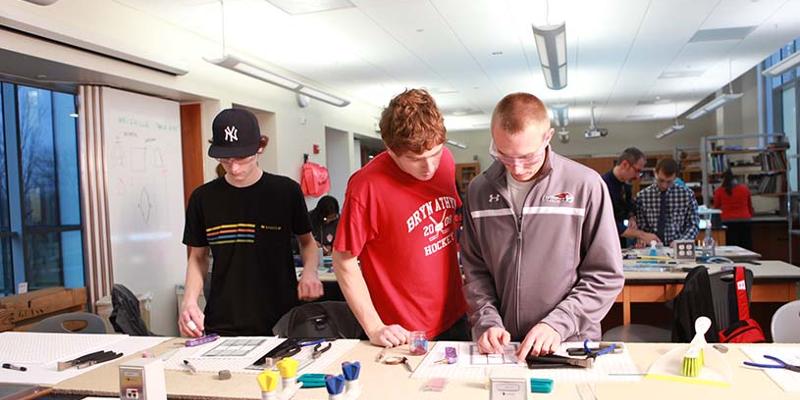Bryn Athyn College’s new building arts Associate in Arts is a pre-professional program open to students of all backgrounds and levels of experience. In addition to core liberal arts courses (such as art history, social science, and religion) the new program includes studio courses in metal forging and stained glass. Art Department Head Martha Gyllenhaal, Ph.D., says, “The program encourages students to explore the fundamentals of building arts, develop relationships with mentors in the field, and participate in internships. These learning experiences will help pave the way to a number of career choices.”
So, what exactly are the “building arts?” The term refers to crafts that blend form and function, leading to beautifully constructed buildings. Think of wrought iron doors, stained glass windows, and stone archways, where decorative elements both sustain and enhance the architecture.
The curriculum for the College’s new building arts program grows naturally from Bryn Athyn’s rich and beautiful history, says Martha. She explained, “As a center for education structured by the study of the Old and New Testaments and Writings, the College’s mission dovetails perfectly with the art department’s focus on the arts as forms of spiritual expression.” She believes that nowhere have these sentiments been more exquisitely illustrated than in the Bryn Athyn Cathedral and Glencairn, two magnificent structures that lie at the heart of the new building arts program.
Since its inception, this program has sought ways to reinvigorate the practice of the crafts used in the workshops that carved the stone, forged the metal, and produced the stained glass for these iconic structures. In recent years, with the hiring of new staff, as well as with financial support from various donors, the possibility of developing a full, on-campus building arts program has become a reality.
After receiving support to create a building arts curriculum, the question arose: where would we have the hands-on labs? Where would the lectures take place? Since one of the town’s original outdoor stone carving workshops still exists (on the Cathedral grounds), limited stone carving courses became an immediate possibility. Glass painting and metal forging, however, required additional studio space. With financial support from the Glencairn Foundation, Asplundh Foundation, Iron Studio, and private donors, the College was able to convert the former Glencairn heating plant into a forging studio. In addition, a large collaborative lab in the Doering Center has been reserved for fine metals and glass painting.
According to Martha, “Build it and they will come” has been an apt expression for these studios. The art department started to offer metal forging and glass painting in the 2011-12 academic year and introduced the building arts summer workshops the following summer. In 2014, the American Glass Guild (under the presidency of J. Kenneth Leap) held their annual conference on the College campus, bringing several hundred participants. The facilities have also attracted preservation classes; students from the University of Pennsylvania have been coming every year since 2013, and a group from the Pratt Institute of Art came in 2016.
In addition to the old and new workshops and studios, using Bryn Athyn’s landmarks as learning spaces empowers students to explore the structures and their collections, putting them into historical context. This involves interpreting artifacts and doing detective work in Glencairn’s archives. Martha explained, “Student projects might involve scrutinizing letters, analyzing preliminary drawings and old photographs, or searching for notations in historically valuable notebooks.” She added, “Furthermore, the accommodating and professional staffs at our landmarks make it possible for students to do the kind of research typical of graduate students at most other colleges.”
Martha has expressed much optimism about the future of the program. She said, “With a nationally recognized historical district at our students’ fingertips, a thorough curriculum, and the right faculty to facilitate the learning in this specialized field, the future of this signature program holds great promise.” Martha continued, offering a vision of future possibilities: “If the Associate in Arts program is successful, then expanding into a four-year Bachelor of Arts would make sense. The building arts program could also expand beyond curricular uses into production-level studio work for maintenance and conservation of Bryn Athyn’s National Historic Landmarks as well as restoration work for other historical structures. If this happens, our building arts program could become a one of a kind, nationally recognized educational and conservation center. The possibilities are impressive, and we are excited to build toward them one step at a time.”
